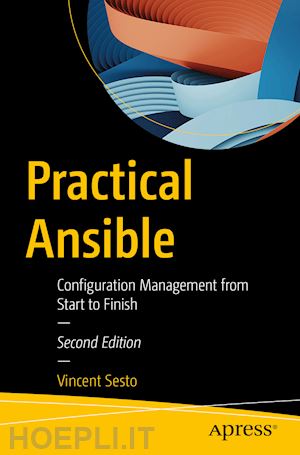
Questo prodotto usufruisce delle SPEDIZIONI GRATIS
selezionando l'opzione Corriere Veloce in fase di ordine.
Pagabile anche con Carta della cultura giovani e del merito, 18App Bonus Cultura e Carta del Docente
Get ready to go from the basics of using Ansible to becoming proficient at implementing configuration management in your projects. This book begins with the basics of Ansible, providing you with details on how to install and configure your environment while working with different Ansible modules from the command line. Next, it introduces you to working with Ansible tasks and organizing configuration code into playbooks.
You’ll then learn how to extend playbooks further, using roles and templates within the configuration code. Author Vincent Sesto then extends your knowledge further by covering custom Ansible modules using Python and Linux shell scripts and demonstrating how you can start to keep your secret values encrypted and secure using Ansible Vault. You’ll also develop Ansible roles with the use of Ansible Galaxy to reuse existing roles that others have created.This updated edition reflects changes added in the latest version of Ansible (2.9). It also includes an expanded chapter on testing Ansible using Molecule and managing large server environments using applications like Ansible Tower.
What Will You Learn
Who This Book Is For
Systems Engineers, Developers, DevOps Engineers and Software Administrators.
Chapter Goal: Introduce configuration management and automation, introduce Ansible
No of pages: 20 - 25
Sub -Topics
Chapter Goal: Expand knowledge of Ansible with an in depth look at Ansible Playbooks
No of pages: 20 - 25
Sub - Topics
Chapter Goal: Expand the LAMP Stack project further expanding the readers knowledge on the use of Ansible Playbooks
No of pages: 20 - 25
Sub - Topics:
3. Configuring Playbooks using conditional tasks and tags to limit what changes are made by the Ansible Playbook.
Chapter 4: Custom Ansible Modules, Vaults And Galaxay’s
Chapter Goal: Provide an introduction to using Ansible Vault to manage their system secrets, as well as exploring Ansible Galaxy to help them fast track their project deployments.
No of pages: 20 - 25
Sub - Topics:
Chapter 5: Working with Ansible In The Cloud
Chapter Goal: The goal of this chapter is to provide a brief introduction to Amazon Web services and get the reader to implement Ansible Playbooks that deploy to AWS.
No of pages: 20 - 25
Sub - Topics:
Chapter 6: AWS Templates and CloudFormation Scripts
Chapter Goal: Expand the readers knowledge further on deploying to their projects to AWS using templates, working with Ansible Pull and using GitHub repository deployments.
No of pages: 20 - 25
Sub - Topics:
Chapter 7: Ansible Troubleshooting And Variables
Chapter Goal: Further our work with some finer points on how we can reduce potential issues from arising in our playbooks and ensure things run as smoothly as possible.
No of pages: 20 - 25
Sub - Topics:
Chapter 8: Testing Ansible Playbooks With Molecule
Chapter Goal: This chapter will introduce setting up a test framework for Ansible playbooks and roles, as well as testing the end state infrastructure of what our Ansible roles are trying to achieve.
No of pages: 20 - 25
Sub - Topics:
1. Introduce Molecule as a way of testing your Ansible code.
2. Provide the basic commands on how to set up your roles and playbooks using Molecule and how to begin testing.3. Discuss how you can set up a workflow to automatically test your code and infrastructure when changes are made.
Chapter 9: Managing Larger Server EnvironmentsChapter Goal: Introduce Ansible Tower to the reader and discuss how you can use the application as part of managing lager server environments. Due to licensing of Ansible the chapter will demonstrate how to use the open source version called AWX.
No of pages: 20 - 25
Sub - Topics:
Vincent Sesto is a DevOps engineer, endurance athlete and author.
As a DevOps engineer Vince specializes in Linux, Amazon Web Services, and open source applications. He is particularly interested in developing his skills in DevOps, continuous integration, security, log aggregation (management, UI, and reporting), and Python development. In his spare time, you’ll find him running or cycling for long periods of time, making the most of his time outdoors.











Il sito utilizza cookie ed altri strumenti di tracciamento che raccolgono informazioni dal dispositivo dell’utente. Oltre ai cookie tecnici ed analitici aggregati, strettamente necessari per il funzionamento di questo sito web, previo consenso dell’utente possono essere installati cookie di profilazione e marketing e cookie dei social media. Cliccando su “Accetto tutti i cookie” saranno attivate tutte le categorie di cookie. Per accettare solo deterninate categorie di cookie, cliccare invece su “Impostazioni cookie”. Chiudendo il banner o continuando a navigare saranno installati solo cookie tecnici. Per maggiori dettagli, consultare la Cookie Policy.